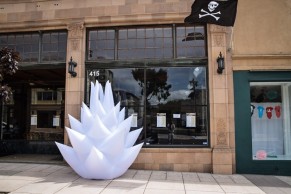Opticos Design was in Vallejo, CA, recently to host a multiday charrette that brought together business owners, property owners, and community members to refine the 2013 Corridor Design Plan’s vision and to establish a framework for the city’s Sonoma Boulevard Specific Plan.
Sonoma Boulevard is Vallejo’s most important north-south corridor; it connects several of the city’s key assets, like the Bay and Vine trails and the city’s historic downtown, and offers access to the Napa River.
The City of Vallejo aims to invite reinvestment to the area by adding new buildings in a variety of sizes for large and small businesses, as well as adding more housing and mixed-use development between the corridor’s several activity nodes. The city hopes that an appealing streetscape, calmer traffic, and new retail stores and businesses will boost interest in the area and create a more vibrant public environment.

The charrette, which took place June 24 – 27 in an unused storefront on Virginia Street, included a discussion on economic development in the area, a community open house, and an informal open studio that gave community members a chance to speak with the design team one on one.
Among the many topics and ideas discussed was the proposed Curtola Gateway roundabout at the intersection of Sonoma Blvd. and Curtola Parkway. The previous plan placed emphasis on area street design. Opticos sought to build on that vision and expand the gateway’s possibilities by focusing on the physical character of surrounding buildings and the roundabout as a whole.
Vallejo has a vibrant art scene—many local artists work with large-scale installations for Burning Man. The new proposal would enlarge the roundabout to serve not only as a gateway to downtown Vallejo, but it would also be an ideal place to showcase local artists.

Incremental changes for existing buildings were proposed, some as simple as re-opening covered windows and converting parking lots to public space. Lower-cost infill could be added to vacant lots to boost activity along the corridor. During the charrette, Opticos created several drawings that incorporated and illustrated both minor revisions and long-term transformations to show community members what existing storefronts and alleyways along the Sonoma corridor could look like.
Another key theme considered during the charrette is what might be possible should long-term plans for new transit-oriented development come to fruition along future rail lines; new transit could connect Vallejo to the Napa Valley and even the Sonoma Marin Area Rail Transit.
The response was overwhelmingly positive, indeed, there wasn’t a single negative comment during Opticos’s closing presentation. “People were excited to see their previous ideas for Sonoma Boulevard turn from concepts and strategies into a series of buildings and detailed improvements for the 1.8-mile plan area,” said Tony Perez, Director of Form-Based Coding at Opticos.
Perez said that while everyone understands it is a long-term project, charrette participants expressed hope and excitement that things are changing for the better in Vallejo. “This ‘project’ will be successful because it will be realized through the work of many rather than a few. There’s a lot to do here and everyone sees that their part will connect with the efforts of others,” he added.
A second charrette will be held July 22 – 25 to discuss the implementation of the plan and to begin developing and testing the future Form-Based Code that will govern zoning along the corridor. The ideas and concepts generated during the two charrettes will form the foundation of the Sonoma Boulevard Specific Plan, a policy and regulatory document for Vallejo’s Sonoma Boulevard corridor.
Click here to download the flyer for the second Vallejo charrette.
Like this article? How about these:
- My First Charrette: Four Days in Vallejo
- DIY Community Character Documentation Launches in Austin
- Building Healthy Communities in South Kern County